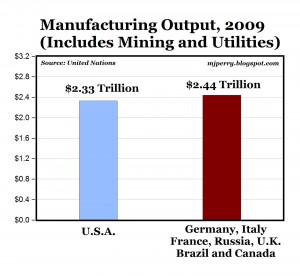Why Manufacturing Jobs Move Overseas (An Apple Case Study) →
This was a very interesting read. If you haven't already read it, you should. Most commenters that I've seen have focused in on the wage differential (and the hours that the Chinese employees work) between U.S. and Chinese workers. That wasn't, primarily, what caught my eye. Instead, it was the overwhelming difference in flexibility.
One former executive described how the company relied upon a Chinese factory to revamp iPhone manufacturing just weeks before the device was due on shelves. Apple had redesigned the iPhone’s screen at the last minute, forcing an assembly line overhaul. … Within 96 hours, the plant was producing over 10,000 iPhones a day.
Can you imagine a union dominated, U.S. manufacturing plant turning around assembly line processes anywhere near that quickly?
Though components differ between versions, all iPhones contain hundreds of parts, an estimated 90 percent of which are manufactured abroad. Advanced semiconductors have come from Germany and Taiwan, memory from Korea and Japan, display panels and circuitry from Korea and Taiwan, chipsets from Europe and rare metals from Africa and Asia. And all of it is put together in China.
Simply put, China is a lot closer to the raw materials than America is. In many cases, it makes a lot of sense to keep the manufacturing plant close to the supply chain.
“The entire supply chain is in China now,” said another former high-ranking Apple executive. “You need a thousand rubber gaskets? That’s the factory next door. You need a million screws? That factory is a block away. You need that screw made a little bit different? It will take three hours.”
How about quickly, nearly instantaneously, finding new employees to ramp up production?
“[Foxconn] could hire 3,000 people overnight,” said Jennifer Rigoni, who was Apple’s worldwide supply demand manager until 2010, but declined to discuss specifics of her work. “What U.S. plant can find 3,000 people overnight and convince them to live in dorms?”
… Another critical advantage for Apple was that China provided engineers at a scale the United States could not match. Apple’s executives had estimated that about 8,700 industrial engineers were needed to oversee and guide the 200,000 assembly-line workers eventually involved in manufacturing iPhones. The company’s analysts had forecast it would take as long as nine months to find that many qualified engineers in the United States.
In China, it took 15 days.
… In particular, companies say they need engineers with more than high school, but not necessarily a bachelor’s degree. Americans at that skill level are hard to find, executives contend. “They’re good jobs, but the country doesn’t have enough to feed the demand,” Mr. Schmidt said.
There are many, many reasons why manufacturing jobs are being created in China and not in the U.S. It's nowhere near as simple as just calling it "greed" and condemning U.S. employers. In a highly dynamic, constantly changing world, is the U.S. producing skilled employees (at all skill levels!) who are willing to quickly change what they do and how they do it?
This entry was tagged. Apple China Jobs Manufacturing
